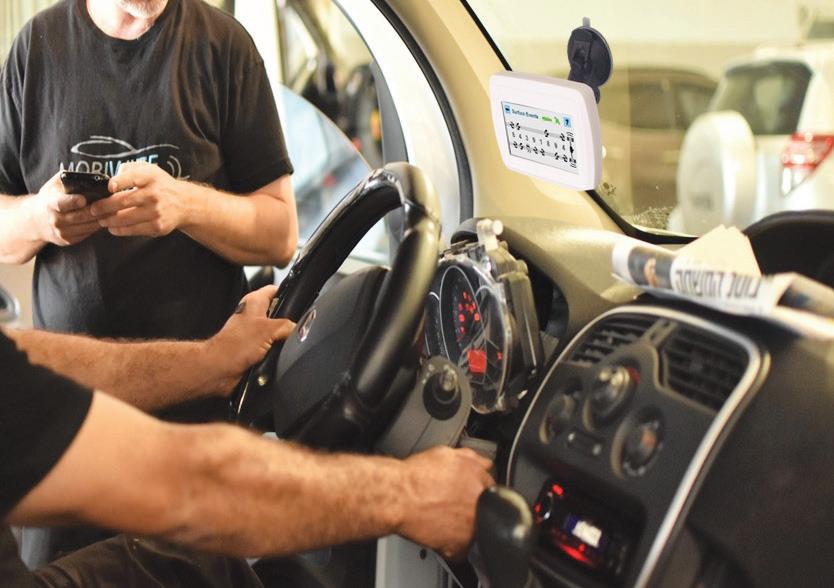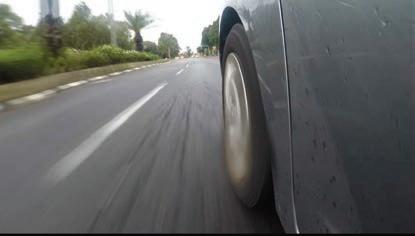
13 minute read
Like Floating on a ‘Cloud
OUR COMMUNITY
ON THE COVER
Advertisement

Members of the team work in the test vehicle.
Like Floating on a


With Detroit’s help, Israeli fi rm creates app to give your car a smoother, more e cient ride.
AMIR SHOAM CONTRIBUTING WRITER
For the past 16 months, 20 of the that had asked the other partners not “I knew nothing about cars or city of Detroit’s vehicles have to name it. mapping, but I knew that I had to been using Israeli software to The company was established in know things about the road, like grades automatically map hazards on the city’s early 2012, under the name MobiWize, and curvatures; and about the vehicle, roads. by Boaz Mizrachi and Yossi Shiri, who like its capabilities and its weight.”
Tactile Processor, developed by were later joined by their friend Alex At some point, Mizrachi had realized Tactile Mobility of Haifa, Israel, Ackerman. While the last two have that most of that data had not existed. gathers data from each car’s built-in left years ago, Mizrachi remains the “I was sure that Google had a map sensors and sends it to the company’s company’s chief technology officer. that showed all of the grades on Earth, Tactile Cloud. Then, the Cloud In 2010, as a lecturer at the but it didn’t,” he said. uses a mathematical model called Technion in Haifa and an experienced “Also, if you wanted to show a 5% SurfaceDNA to combine the crowd- entrepreneur, Mizrachi was presented saving in gas, you’d need to measure it sourced data into a map, with the idea to develop an app that with the mean error being 1% at most. including each road’s would alert drivers if they were going However, a vehicle’s sensor’s mean grade and normalized grip too fast while nearing a stop sign. error is up to 30%, as we had shown.” level, and the locations However, his plans were bigger. The company started as part of a of potholes, cracks and “Gas was becoming very expensive, business incubator and developed an bumps. and everyone was trying to save it,” aftermarket system to be installed Boaz Mizrachi Funded by PlanetM, this proof of concept is a Mizrachi said. “I was trying to solve the problem of how to get a vehicle inside of a vehicle and instruct the driver on how to save gas based on collaboration between the company, from point A to point B with a the characteristics of the road and the the city, and a major local automaker minimum of gas.” vehicle.
PHOTOS COURTESY OF TACTILE MOBILITY
“It would sometimes take it a week or two to calibrate itself for the specific car and roadmap, but eventually it would be super-accurate, like nowhere else in the world,” Mizrachi said.
About one year later, it was a Detroit company’s scout who challenged Mizrachi to create a cloud-based app that would control the car’s speed and gear-shifting according to where the car was heading. Mizrachi worked on the software for a few months, and then went to Detroit and connected his system to a car.
“The car would be driven once or twice, self-learn the map of road grades and what the road looked like, and save it to the cloud,” Mizrachi said. “The next vehicle to drive there would know what’s ahead of it.”
Within two weeks, Mizrachi managed to show a 5% saving in gas relatively to “standard” cruise control. “We had become known within the company, and I returned home with some money for that project,” he said.

SWITCH IN FOCUS
In 2014 Mizrachi’s company recruited three private investors from Israel, Spain and Mexico, and got out of the incubator. He hired between 15 and 20 of his best students and got to work. “We created a beautiful technology,” he said. “We demonstrated the ability to estimate a truck’s weight with a 2% mean error.
“We started working with automakers, understanding their needs, and showing them that the same building blocks can create interesting insights.”
The twist in the company’s story came shortly afterward, when gas prices tanked. “Nobody cared about saving gas anymore,” Mizrachi said. “On the other hand, it turned out that all of the infrastructures that we had created were worth a lot, for they allowed a car to do other things, especially if that car was autonomous.”
While other companies trying to develop autonomous driving rely mostly on visual sensors, Mizrachi had realized that pictures do not show the full picture.
“Not everything can be seen,” Mizrachi said. “Some things you need to feel. Imagine yourself remotely driving a car using cameras and a steering wheel in your office. That is not the same.”
The company has created a language in which every pothole or bump is a different word. Those words are created using two mathematical models: While SurfaceDNA is a “digital twin” to the road, VehicleDNA is the same to the vehicle, creating real-time “virtual sensors” of the vehicle’s weight, fuel consumption, tire health and more.
Mizrachi said that the data that his company generated was more valuable than alternative solutions:
“If a driver turned on the wipers, you could guess it rained. If I had connected millions of cars to a cloud, I’d have a map of where it rained that day around the globe. However, just because it rained, and the road is wet doesn’t mean it’s slippery.
“You could drive the Cross-Israel Highway at 95 mph in pouring rain and everything would be fine,” he continued, “but in some places in Israel, even at 40 or 50 mph, very little rain can send you flying. It depends on the road’s texture, how much water has accumulated on it, the kind of asphalt on the road and your own tires.”
Data collected from the Tactile Processor
— BOAZ MIZRACHI
AUTOMAKERS STEP IN
The company had been working with U.S. automakers for a few years, and then the Europeans joined in.
“Four years ago,” Mizrachi said, “a BMW software developer called me from Munich and said, ‘Imagine that in 2021 a car will be able to self-drive at 160 mph with the driver sleeping.’ I said, ‘I wish the driver luck. Why do you think I can help?’ He said that an essential condition for that would be knowing the grip level between the car and the road 300 yards ahead.”
Other German automakers quickly realized the potential of the unusual partner and also how unusual it was.
“We do things that are completely different than what the industry does,” Mizrachi said. “We are not car engineers. The first time that I arrived in Germany to install the system on a Porsche vehicle, they opened the engine cover and I asked, ‘Where has
continued on page 14
OUR COMMUNITY
ON THE COVER
continued from page 13
the engine gone?’ They told me that in Porsche cars, the engine is at the rear.” In 2018, the company hired a vice president of business development, Eitan Grosbard, who was Eitan previously responsible for Grosbard mergers and acquisitions at Gett.
“I had known the automobile industry, but from a different angle,” Grosbard said. “I have entered a whole new world of software and data monetization.”
In 2019, the company has gained two major investors: Porsche and Union Motors, Toyota’s importer into Israel.

DETROIT’S ROLE
In October of that year, Detroit had become one of several cities around the world to collaborate with Tactile Mobility on a proof of concept.
“The automaker was the one that has put this whole story in motion,” Grosbard said. “Its people said that they were already selling cars to municipalities, but they wanted to start selling service as well.
“It was the first time that I wasn’t working with a city alone,” said Grosbard, who added that a similar type of collaboration is already taking place in Germany, with unnamed partners.
In recent years, the city would rely on citizens using the SeeClickFix app, and a team of people actively searching, to know about road deficiencies. The project’s manager on the city’s side, Samuel Krassenstein, said that Tactile Mobility’s data had changed things.
“Traditionally, when we’d do a road analysis, it was based on a visual assessment of the road, but that rating system isn’t necessarily aligned with where drivers are facing the most pain,” he said. “This type of analysis is based on ride quality. The combination of them ends up working very well.”
Krassenstein said that the project was made unique by the passive form of data collection.
“We did not tell our staff in our vehicles where to drive. We just let them go on their daily business. We’re pretty happy with the coverage of the city we got just on 20 vehicles.” While the city currently receives raw-data monthly reports, Krassenstein expressed hope that in the future, the data would be more “real-time” and “consumer-ready.”
Grosbard said that a relevant system would be ready by Q3 2021.
Mizrachi said that even for cities with limited budgets, the system would be a worthwhile investment:
“When we installed a similar system in our hometown Haifa, they said, ‘We know that our roads are completely ruined. Instead of paying you, we could fix a couple of potholes that we know about.’ We explained to them that some roads are bad enough to make a car crash, even because of a small pothole — if its edge is steep enough, or if it’s exactly on the tire track. Especially if you have tons of potholes, you should know which would cause the most damage.”
Last year, both Porsche and BMW announced that they would use Tactile Mobility’s technology in their cars.
Last December, two more investors have joined in: Nexteer, a company that provides solutions to automakers in the steering department, and The Group Ventures, a Canadian venture capital fund for special AI-based technologies.
“We are preparing for another investment round this year,” Grosbard said.
Today, the company has almost 30 workers. The interim CEO for the past few months has been Rani Plaut, a well-known entrepreneur, and a board member and an adviser to the company for several years.
was made unique by the passive form of
Samuel Krassenstein
The Tactile Processor
PROBABLE COMPETITORS
Both Grosbard and Mizrachi acknowledged that their system’s success may provoke a stiff competition but showed optimism.
“Competition only strengthens the notion that the product is needed,” Grosbard said. “That way, potential clients will also know that they aren’t dependent on us alone.”
Mizrachi said that the quality of Tactile

Video and data from the pilot program
continued on page 16


OUR COMMUNITY
ON THE COVER
continued from page 14
Mobility’s engineering could give it the edge:
“Many machine-learning companies try to get into vehicles, and usually they rely on super-heavy resources,” he said. “NVidia is trying to get its heavy processors into vehicles. If you count on a very heavy processor in the car, in terms of price, power draw, size, etc., the number of cars that you’ll get into is small.
“However, if you aim your technology toward very lean and cheap computers — if you have reliable machine learning in 200 kilobytes — then you win. That is the difference between a company that sells millions of units and a company whose product is sold alongside a couple of luxury vehicles in Abu Dhabi.”
Grosbard said that data such as tire health, for example, had many possibilities for future monetization:
“Tire manufacturers can use this information for R&D — how long it takes their tires to wear out, what different geographical areas can indicate, the kind of drivers that use their tires and so on — and for marketing and sales.
“Vehicle fleets can use the same data. Tires are the second-highest operational
expense for motor vehicle fleets, after gas. They’ll be able to receive an indication about tire health in all of their vehicles.
“As an insurance company, if I knew your tire condition, I could tell you that if you don’t replace your tires, your risk profile will be higher.
“Lastly, if the automaker knows that your tires are worn out, it can draw you into its repair shop.”
Mizrachi was looking a few years into the future:
“Our vision is ‘Tactile Inside.’ We want our software to be embedded in as many cars of possible out of the manufacturing strip — at least 10 million cars. As soon as that happens, we’ll have a map of the world’s roads with very high quality and refresh rate.”
“We’ll be happy to become a supplier of innovative information to all of the municipalities in the U.S.”
— BOAZ MIZRACHI
Start the New Year Off Right!
As featured on: Need Help with an IRS or State Tax Problem? Call the experts at • Tax Liens • Collection Notices Need Help With An IRS or State Tax Problem? Let our team of Attorneys, CPAs, Tax Consultants
and former IRS Revenue Offi cers provide you with • Penalties immediate relief. • Unfi led Tax Returns • Audits

Why Choose Levy & Associates to help M.F.: Owed the State of Michigan $100,578. 1-800-TAX-LEVY (829-5389) With our help, the case was settled for $100. R.N.: Owed the IRS $709,000. Our fi rm negotiated an Off er in Compromise with your tax problems? • 22 years of specializing in tax resolution and working with the IRS and State Taxing Authorities to settle the debt for $1,000. Tax Liens Collection Notices Let our team of Attorneys, CPAs, Tax Consultants and former IRS Revenue O cers provide you with immediate relief from IRS and State tax problems. S.F.: With our assistance, client’s IRS debt of $207,663 was reduced to $5,837. • We have helped thousands of clients nationwide to SAVE TENS OF MILLIONS OF DOLLARS EACH YEAR!
Penalties Unfi led Tax Returns Audits Owed the IRS $207,214. With our help, the case was settled for $7352. Client owed the IRS Why Choose Levy & Associates to help with your tax problems? • 22 years of specializing in tax resolution and working with the IRS and State Taxing Authorities • We have helped thousands of clients nationwide to save tens of millions of dollars each year! • Unlike other fi rms, all work on your account is kept in-house • A+ rating with the Better Business Bureau As featured on: Need Help with an IRS or State Tax Problem? Call the experts at 1.800.TAX.LEVY www.levytaxhelp.com Call us today to answer your questions or to schedule a meeting and say goodbye to those sleepless nights! • A+ rating with the Better Business Bureau We Listen... We Care... We Help! Results will vary based upon clients fi nancial condition. $110,203. Our rm negotiated an Offer in Compromise to settle the debt for $12,226. Sincerely, 1-800-TAX-LEVY (829-5389) AS FEATURED IN Call us today to answer your questions or to schedule a meeting and say 28400 Southfi eld Rd, Lathrup Village, MI 48076 16 | FEBRUARY 25 • 2021 goodbye to those sleepless nights! With our assistance, client’s Lawrence B. Levy, President Let our team of Attorneys, CPAs, Tax Consultants and former IRS Revenue O cers provide you with 1-800-TAX-LEVY (829-5389) IRS debt of $1,014,078 was reduced to $100,490. Collection Notices immediate relief from IRS and State tax problems. Why Choose Levy & Associates to help with your tax problems?











